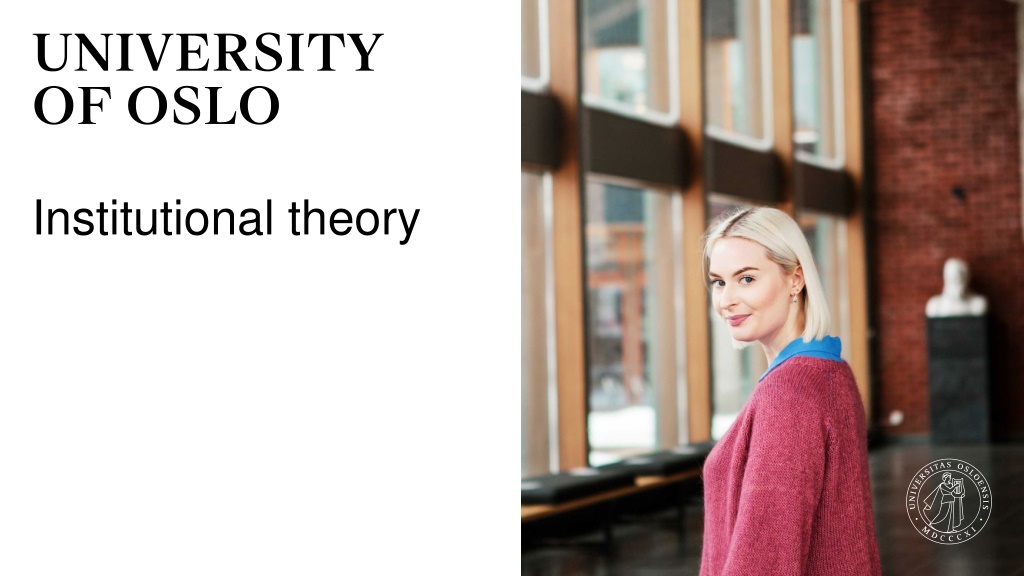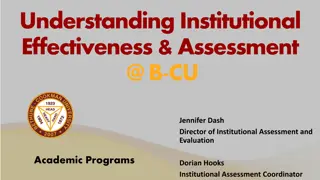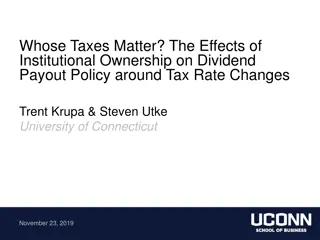Understanding Institutional Theory and Organizations
Explore the concept of institutional theory, which focuses on the stability and change of institutions and organizations. Learn about institutionalization, deinstitutionalization, and reinstitutionalization, as well as the definitions of institutions and organizations. Discover how institutions like family, religion, and businesses shape society.
Download Presentation

Please find below an Image/Link to download the presentation.
The content on the website is provided AS IS for your information and personal use only. It may not be sold, licensed, or shared on other websites without obtaining consent from the author. Download presentation by click this link. If you encounter any issues during the download, it is possible that the publisher has removed the file from their server.
E N D
Presentation Transcript
What are we trying to understand? What are some topics you are interested in? Intersection of technology and organizations? What are organizations? What do they do? Why do they do that? Why do we do things the way we do them? Page 2
What are we doing today? Looking at a specific theory that we can use to understand digitalization Illustrated by non-IS examples. In the seminar you ll use it with IT/IS Theory as a lense to focus our view An example or two of using the lense in IS Page 3
What is Institutional Theory, and what can we use it for? Institutional theory concerns stability and change of institutions and organizations Institutionalization is the process by which an institution attains a stable and durable state or property Deinstitutionalization is a process by which the legitimacy of an established practice erodes or discontinues Reinstitutionalization is an exit from one institutionalization, and entry into another institutional form Page 4
Institutions and organizations What are institutions? Many definitions, some commonalities: Multi-faceted, durable, social structures, made up of symbolic elements, social activities, and material resources - Scott (2001) Family, religion, economic systems, legal systems, language, mass media, businesses, academia, the nation-state, art What are organizations? A school is an organization; education is an institution A football club is an organization; football as a game is an institution An organization is a player, while institutions are the rules of the game Page 5
Football as institution Page 6
Family as institution? Multi-faceted, durable, social structures, made up of symbolic elements, social activities, and material resources Formal rules (marriage, laws, etc), informal rules (on adultery, division of responsibilities), other symbolic elements (wedding, ring, mother in law ), social activities (vacation, common meals, etc), material resources (shared home, the table around which you gather for dinner, etc) Is this institution similar all over the world? How stable is it? Is it changing? Page 8
Health system as institution? Multi-faceted, durable, social structures, made up of symbolic elements, social activities, and material resources - Scott (2001) How would you describe the health system in Norway as an institution? Page 9
Why are institutions interesting from an IT/IS perspective? Instititutional theory is/has traditionally been concerned with stability, while technologies are often associated with rapid and sometimes disruptive societal and organizational changes Developing and using IT are subject to social pressures (not necessarily felt or understood) We, developers and users, are actors in many institutions So: IT influence institutions, and institutions influence IT Page 10
Can better explain adoption (or non-adoption) of IT Institutional theory brings in the social context, challenging an economic- rationalistic perspective The boundary of rational choice (about IT) is socially constructed, and if legitimated and taken for granted as a social fact, operates and persists even beneath the level of consciousness We (and our organizations) act out of socially constructed ideas of what is beneficial. We use institutional arguments rather than rational choice arguments In other words, we behave within the rationalities of our environment Provides an understanding of phenomena not so well explained by economic- rationalist models, such as the wide adoption (or non-) and acceptance (or non-) of IT innovations Page 11
What is this? Page 12
Some central topics and concepts from Institutional theory - we have already looked at institutions and organizations Page 13
Organizational field Those organizations that, in the aggregate, constitute a recognized area of insitutional life DiMaggio and Powell 1983 All universities and university colleges in Norway (all universities in the world?) The players (organizations) that play a certain game (institutions). In this case, the game of higher education . Page 14
Organizational isomorphism Isomorphism: to become the same Within an organizational field, researchers found rational actors make their organizations increasingly similar as they try to change them Universities operate more or less the same way? Page 15
Why this? Page 16
Organizational isomorphism Coercive isomorphism: formal and informal pressures exerted on organization by powerful entities such as the state and by cultural expectations in the organization s environment Mimetic isomorphism stems from uncertainty. When things are uncertain (as with new technologies), you watch what others are doing and model yourself after them Normative pressures stem largely from professionalization. Collective struggle of members of an occuption to define conditions and methods or their work Page 17
Institutional logics sets of material practices and symbolic constructions which constitute a field s organizing principles and which are available to organizations and individuals to elaborate Friedland and Alford 1991 Formal and informal rules of action, interaction, and interpretations that guide and constrain decision makers. Cognitive maps and belief systems. Example: Our economy (an institution) has certain shared belief systems (such as capitalism). Alternatives? Communism/planned economy Islamic banking (no usury, profit and loss sharing, etc) Example: Family. The same elements present worldwide, but understood differently Page 18
Paradox of embedded agency If actors are embedded in an institutional field, acting according to the field s regulative, normative, and cognitive processes, how can they even see a different way of doing things, and make others adopt it? In other words: If all you know is apple, how can you even envision a banana? And not to mention change all the rules if the rules determine your behaviour? Page 19
One attempt: Institutional entrepreneur Institutional entrepreneurship activities of actors who have an interest in particular institutional arrangements and who leverages resources to create new institutions or to transform existing ones Maguire, Hardy, and Lawrence 2004 Re-introduction of agency and interest into institutional analysis. We are not slaves of our institutions. Furthermore, we are not only part of the institutions in which we work. While I m in the academic world , I am also living within many other institutions (parliamentary democracy, market economy, Western popular culture , etc etc), which may shape my conceptions of work practices at the university. Page 20
Summary Institutions are those social structures that, often uncounciously, structure our behaviour They are often sticky , or stable, resisting change. But they DO change When we follow the rules , we also reinforce them Organizations are entities that follow these rules. Universities, hospitals, sport clubs, scouts, transportation companies, etc Page 21
How can Institutional theory help us? An example of understanding digital transformation in the HIS space. Page 22
Capacity building for DHIS2 using institutional theory? Page 23
The promise! Online course is cheap! Create once, free use afterwards No travel needed, no venue, no lunch, no hotel Online course is flexible! Follow it whenver you have time Do as much or as little as you want at any given time On the bus? At home? At a boring party? You re welcome! Unable to meet due to Covid restrictions? No problem! Page 25
However. How will this work? Can we just make an online course and make everyone happy? RQ: How does the existing institution of in-service training shape the introduction of online training for health staff in Indonesia? Page 26
We examined three modes of training 1. Onsite training, which is the norm in this context: trainers and trainees meet at a venue (hotel or similar), traveling from where they work. Training lasts from a few hours to several days. Similar to a classroom 2. Asynchronous online training. Online course developed, trainees sign up and complete online at their own pace 3. Synchronized online training. Due to problems with poor completion of the asynchronous training, and travel restrictions due to covied, this was more like an online classroom session. Fixed times, more interaction, instructor-led Page 27
Examining different practices to understand the underlying institutional logics Practices of budgeting, scaling, organization of training, time allocation The institutional logics (underlying assumptions) of onsite and online training differed Ran into challenges and low completion rate partly due to mismatch of logics Page 28
What did institutional theory give us? A lens to focus on the social/cultural/organizational aspects of the digitalization effort What are the organizers, trainers, and trainees behavior, and why? A language to describe these aspects Institutional logics A literature to engage with and learn from Page 31
Understanding digital (non)transformation using institutional theory? Page 32
Institutional logics of HIS Institutional logics as the socially constructed, historical patterns of material practices, values, beliefs, and rules by which individuals produce and reproduce their material subsistence, organize time and space, and provide meaning to their social reality (Thornton and Ocasio, 2008) They work at different levels, and multiple logics may be simultaneously at play, contributing to institutional contradictions (Friedland and Alford, 1991) Two dominant logics had implications for what we tried to do: Central planning logic Logic of technology (paper-oriented) These logics are the products of our analysis, an example of IS researchers using institutional concepts perhaps with too shallow an understanding. But, they had analytic value for us. Page 33
Two sets of conflicting logics Statistics for central planning and control versus using information for decentralized action Rigidity of paper-based reporting formats versus the flexibility of customizable electronic forms Page 34
References Currie, Wendy L. Institutional Theory of Information Technology. Oxford University Press, 2011. https://doi.org/10.1093/oxfordhb/9780199580583.003.0008. North, Douglass C. Institutions. The Journal of Economic Perspectives 5, no. 1 (1991): 97 112. https://doi.org/10.2307/1942704. Sahay, Sundeep, Johan Ivar S b , Selamawit Molla Mekonnen, and Abyot Asalefew Gizaw. Interplay of Institutional Logics and Implications for Deinstitutionalization: Case Study of HMIS Implementation in Tajikistan. Information Technologies & International Development 6, no. 3 (2010): pp-19. Chrysantina, Aprisa, Johan Ivar S b , and Jens Johan Kaasb ll. Introducing Online Training for Health Staff: An Institutional Perspective. THE ELECTRONIC JOURNAL OF INFORMATION SYSTEMS IN DEVELOPING COUNTRIES n/a, no. n/a (n.d.): e12233. https://doi.org/10.1002/isd2.12233. Thornton, Patricia H., and William Ocasio. "Institutional logics." The Sage handbook of organizational institutionalism 840.2008 (2008): 99-128. Scott, W. Richard. Institutions and organizations: Ideas and interests. Sage, 2008. Friedland, Roger. "Bringing society back in: Symbols, practices, and institutional contradictions." The new institutionalism in organizational analysis (1991): 232-263. Maguire, Steve, Cynthia Hardy, and Thomas B. Lawrence. "Institutional entrepreneurship in emerging fields: HIV/AIDS treatment advocacy in Canada." Academy of management journal 47.5 (2004): 657-679. Page 35























